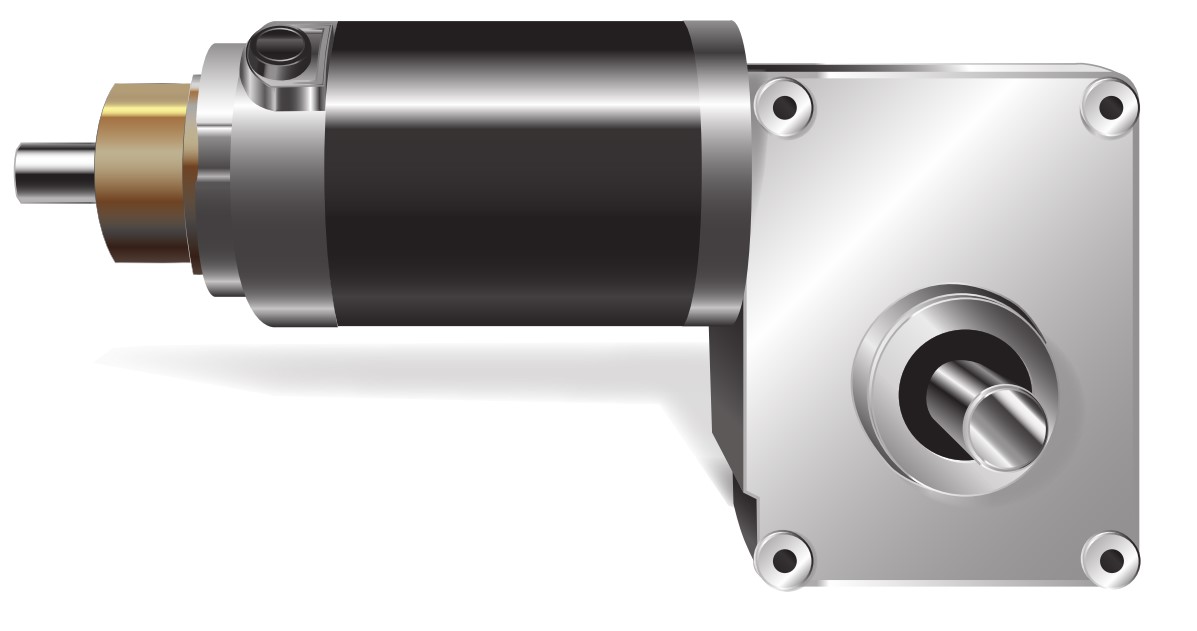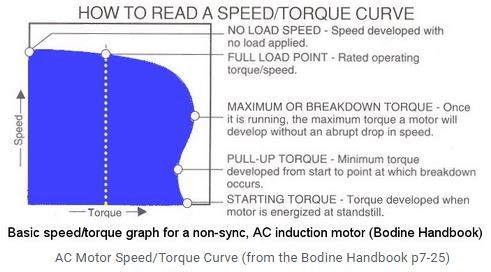One of the conveniences of using a “power off” (spring-loaded) DC holding brake is that it can be wired in parallel with the motor power leads so that it will engage when power is removed from the motor. Most times this works as expected, however here are a couple of special cases to keep in mind:
1) When power is removed from the motor (and brake), the gearmotor/motor acts as a generator as long as the armature is rotating. If the load has any inertia or momentum, it can still generate enough power to keep the brake from engaging right away. Eventually the armature speed decreases due to load friction and the brake can engage, but this could take milliseconds or seconds depending on the type of load. Usually not a problem, but good to be aware of the possibility.
2) In cases where the gearmotor load requires a high starting torque, the armature can draw a lot of current from the power source. If the leads are longer than a couple of feet, then the voltage drop along the wires could be enough that the brake doesn’t disengage right away. This makes the motor power through the load AND the brake and possibly creates premature wear on the brake disk.

The rated (nameplate) torques for stock gearmotors and motors shown in our catalog and on our website are for continuous duty operation. And while our standard/stock products are rated for continuous duty operation, they can also be used intermittently. Operation at loads higher than nameplate ratings is possible for short periods as long as there are rest periods for cooling. Loads higher than obtainable torque for gearmotors are never recommended. The temperature of the motor should be monitored during testing to make sure it is not overheating.
Obtainable torque is the maximum output torque (peak torque) for a gearmotor. Gearmotors may be operated at these levels only for brief periods due to thermal or mechanical limitations.

All Bodine stock gearmotors and motors are designed so that rated (nameplate) torque, shown in our catalog and on our website, is safe for continuous duty operation. These continuous duty stock products can be used intermittently, as well. Operation at loads higher than nameplate ratings is possible for short periods as long as there are rest periods for cooling. Loads higher than obtainable torque for gearmotors are never recommended. The temperature of the motor should be monitored during testing to make sure it is not overheating.
Obtainable torque is the maximum output torque (peak torque) for a gearmotor. Gearmotors may be operated at these levels only for brief periods due to thermal or mechanical limitations.

AC three-phase inverter duty (PP), three-phase synchronous inverter duty (YP), and some permanent split capacitor (PSC or CI) designs may be operated at adjustable speed with suitable controllers.
Adjustable speed systems are sometimes appropriate for single speed applications. If the desired speed is not known or not offered in a single speed product, an adjustable speed system may be set to the desired speed. For a low volume requirement, this approach will normally be more cost effective than changing ratios or making up special gearing.

Most 24A stock gearmotors and motors are rated IP-20, but we offer an IP-44 seal kit. The part number of this IP-44 seal kit is stock model 0976. Our type 24A-60P planetary gearmotors are rated IP-65 and do not require this kit

Motors without gearing and K-2 gearmotors may be operated in any position. Standard Bodine gearmotors are designed for universal horizontal mounting with the motor portion or the drive shaft horizontal. Other mounting positions are possible, depending on the gearmotor type (and lubricant). Some gearmotors are oil lubricated. If these gearmotors are mounted in a position other than horizontal, the oil might find its way out of the gearbox as the motor shaft or the shaft seal wear out over time. When in doubt, please consult our technical support staff in Northfield (Chicago area). You can e-mail us at info@bodine-electric.com.

A motor designed for 60 Hz operation will run at 5/6 rated speed on 50 Hz. This can be of concern for totally enclosed, fan cooled (TEFC) motors or gearmotors. For example, a motor rated 1700 RPM on 60 Hz will run at 1400 RPM on 50 Hz. When the motor fan runs slower, the motor winding will receive less then the expected cooling.
Bodine 60 Hz permanent split capacitor (PSC) "Cl" motors will run hotter on 50 Hz, and typically require a capacitor change and derating. The motor temperature should be monitored during testing to make sure it is not overheating. Bodine split phase (or "Sl") motors and gearmotors that are rated for 60Hz should not be operated on 50 Hz because the internal centrifugal cut-out switch will not cut out correctly and might damage the start winding. Consult the factory for a 50Hz solution.

Operation of more than one motor from a single control is not normally recommended (PMDC or BLDC). However, when cost is a primary concern, a multiple motor/single control system with either permanent magnet motors and control or 3 phase motors and control may be successfully implemented. More than one AC three-phase, inverter duty motor/gearmotor may be operated with a single AC speed control (=inverter, = adjustable speed drive), as long as the sum of the motor currents does not exceed the rated output current of the control. Motor speeds should not fluctuate as long as the motors are not overloaded and the sum of the motor currents does not exceed the rated output current of the control.

It depends on why you are measuring the current. A DC current reading will be a good estimate you can use to size the motor for a torque rating. If you want to measure current in order to determine whether or not your motor/gearmotor is sized adequately (i.e. you want to load test your motor/gearmotor by measuring current and calculating torque from measured current), use a DC current reading.
An AC current reading will be essentially the same as the true RMS current through the motor. This is a better measure of the current that is flowing through the motor. This measurement will be more useful if you want to determine the amount of dissipated heat the motor is producing.

Gearmotors are ideal for applications that require high output torque in the smallest possible drive package, or when the motor output speed needs to be reduced. Their high torque-to-size ratio makes them the ideal drive solution for tight spaces, or when the overall machine design needs to be optimized for the smallest possible motor footprint. The inherent benefit of integral gearmotors is that they function as torque multipliers and speed reducers, requiring less motor power to drive a given load. The gear housing design, the gearing type, gear lubrication, and the specific mode of integration all affect the gearmotor performance, and application suitability.

Brushless DC (BLDC) gearmotors are typically quieter than PMDC gear motors or inverter-duty AC three-phase gearmotor and motor designs. PMDC gearmotors have carbon brushes that continuously “rub” on the commutator of the motor armature. This interaction, along with the DC power from an unfiltered SCR or PWM speed control can result in audible noise. Similarly, inverter-duty, variable speed AC motors and gearmotors emit some noise created by the PWM voltage supplied to the motor from the inverter (PWM speed control). Gear housing style and design, as well as the number of gear stages can also affect overall noise emitted from the gearmotor. Worm gearheads (right-angle gearmotors) are generally quieter than inline or parallel shaft gearmotors due to the differences in gear geometry and how the gear sets interact.

Download our informative Gearmotor Selection and Application Guide – then consider these basic design criteria to determine which gearmotor is right for your application
- Intermittent vs. Continuous Duty
- Speed and Torque
- Gearhead Life
- Output Torque
- PMDC vs BLDC or AC power
- Mounting Orientation
